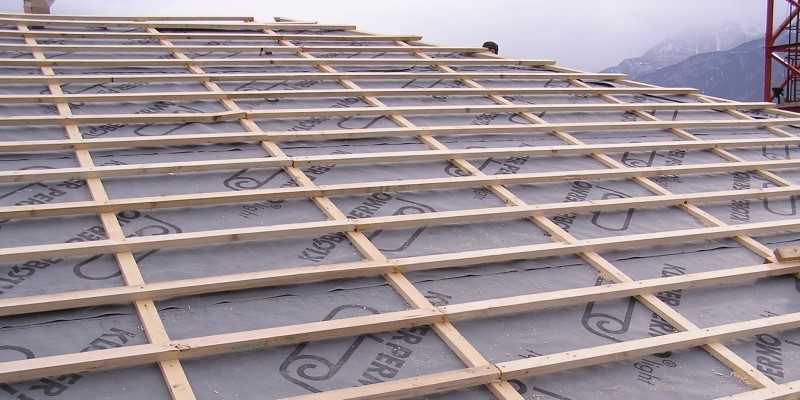Mega Guide to Roofing Membranes and Underlays

Roof membranes and underlays are a vital part of any tiled roof. By providing additional security against water ingress and nightmare leaks, they help to keep your roof looking at performing at its best for longer.
Why is Underlayment Needed?
Whilst roof shingles and tiles do provide a reasonable degree of protection against the destructive effects of external weather conditions, roofing underlayment adds an important secondary layer of protection that ensures a more resilient and long-lasting lifespan for your roof structure. The right underlayment will not only shield your roof structure from weathering prior to shingle attachment, but also defends your sheathing from potential wind, moisture and ice dam damage long after installation is complete.
Breathable vs Non-Breathable Membranes
Non-Breathable Underlay
Whilst non-breathable underlays are not air permeable, they are still a traditionally popular
choice for cold roof structures with eaves and ridge ventilation already installed. There are a variety of non-breathable underlays out there on the market, including both classic bituminous and more modern impermeable membranes manufactured using materials such as polypropylene.
Although breathable membranes have significantly increased in popularity in recent times, the conventional and trusted performance of non-breathable underlayment has proven its effectiveness as an active secondary barrier against high winds and harsh elements.
In roofing structures that utilise counter-battens to ventilate the batten void, a practical and affordable method is to install a non-breathable membrane such as lightweight or reinforced bitumen membrane.
Breathable Underlay
A more modern approach to roofing underlayment, breathable underlays provide multi-purpose performance in creating both a protective weather barrier as well as enhancing structural ventilation. Breathable underlays typically work best when installed below your roof slates or tiles, allowing the property to breathe through the release of moisture from the building.
There are two main types of breathable underlay available: vapour permeable and air & vapour permeable.
Vapour permeable underlays are the most common type available, designed to provide additional roofing air circulation whilst used alongside alternative ventilators. With a dramatic increase in interior building insulation and therefore higher concentrations of internal water vapour, vapour permeable underlays offer an effective solution to optimising air-flow and reducing the risk of heavy condensation within the building space.
A relatively new innovation in breathable underlay design, air and vapour permeable underlays can be used as a solitary form of ventilation for cold roof structures without the requirement of additional ventilation measures in place. Although more expensive than vapour permeable and non-breathable underlays, air and vapour permeable underlays have proven to be exceedingly popular across the board for the simplification and ease of the ventilative performance they provide.
Different Types of Roof Underlayment
Felt Underlayment
Trusted as an effective underlayment for hundreds of years, roofing felt is still used in modern roofing construction today to create an effective barrier against the potentially damaging effects of sun, wind, rain and hail.
Roofing felt was originally used as a temporary waterproofing cover whilst a shingled roof was amid construction. The felt helped to protect the roof structure from water damage as well as creating a safer, less slippery layer for the roofing installers to work upon.
Another innovative advantage of roof felt valued more in contemporary home construction is that it can also act as an effective moisture barrier too. As hot air rises through your home and reaches the roof, the moisture in the air that that would otherwise condense on the underside of the shingles, instead gets caught by the felt. This helps to minimise any damage to the wood sheathing over the long-term.
Self-Adhered Underlayment
As implied in the name, self-adhered underlay has a sticky back surface which adheres directly to the roof sheathing and creates a robust waterproof seal. Manufactured with high percentages of asphalt and rubber polymers, this water-resistant underlayment protects the roof structure from potential water damages, especially in leak-prone areas such as the eaves, valleys, vents, chimneys and skylights.
In many self-adhered underlays, the upper surface layer contains granulated, polyester or polyethylene materials which offer excellent weather-resistant properties and also form a non-skid surface that is safer to walk across during installation. Self-adhered underlayments are typically recommended in climates that experience severe wintry conditions.
Synthetic Underlayment
Currently the most popular underlayment choice in the world of roofing, synthetic underlays offer exceptional standards of strength, resilience and tear-resistance even when faced with highly adverse conditions. Although far more lightweight than similar alternatives, synthetic underlayment is far more durable and longer-lasting, offering high UV and moisture resistance. This is especially beneficial if you plan to leave the underlay exposed for extended periods of time during or before work commences.
In terms of the installation itself, synthetic underlays are much quicker, simpler and safer to install. As most synthetic types come in wider and longer rolls, this allows faster and easier coverage in one go with fewer trips and up and down the ladder. They are also typically well-marked with overlap guides and indicator lines to enhance efficiency and accuracy during the fitting process.
Where Can I Find High-Quality Roof Underlayment?
When it comes to picking out a suitable roof underlayment, its important to invest your money in membranes and underlays that are manufactured to a professional-standard quality. Here at Roofing Megastore, we’ve made it our goal to offer just that to our customers.
Exploring our fantastic selection of roof membranes, you’ll find a practical selection of types and materials from market-leading brands you can trust. For extra help in choosing the right membrane or for any other questions and queries, don’t hesitate to get in touch with our friendly customer service team who will be more than happy to help. Give them a call on 01295 565565, email [email protected], or leave us a message in our handy live chat below.